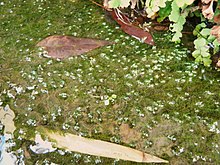| Leptodictyum riparium | |
|---|---|

| |
|
Scientific classification
| |
| Kingdom: | Plantae |
| Division: | Bryophyta |
| Class: | Bryopsida |
| Subclass: | Bryidae |
| Order: | Hypnales |
| Family: | Amblystegiaceae |
| Genus: | Leptodictyum |
| Species: | L. riparium
|
| Binomial name | |
| Leptodictyum riparium (Hedw.) Warnst.
| |
Leptodictyum riparium, commonly known as Kneiff's feathermoss, [1] streamside leptodictyum moss, [2] or knapwort, [3] is a species of moss [4] of cosmopolitan distribution. The only places it is not found are the Pacific Islands and Australia. [3] It is commonly found growing in the lakes and rivers of Minnesota [5] and is also present in Mexico, Guatemala, the Bahamas, Cuba, Jamaica, Haiti, the Dominican Republic, Venezuela, Peru and Brazil. [6]
This moss has several different forms and can grow up to 30 cm. Its ovate leaves, which are in two rows, are often pointed at their apex. [3] Leptodictyum riparium has been found in an acidic mining lake and can live at a pH down to 1.6 in volcanic craters. It was once found with Eleocharis acicularis at a Canadian mining lake. [7] It is known to contain high levels of phosphate [8] and is an easy to grow moss that is also used in aquariums. It has been reported that L. riparium tolerates a wide range of nutrient conditions and its population increases as ammonia increases. [9]
Leptodictyum riparium is known to be able to use artificial light to grow in places which are otherwise devoid of natural light, such as Crystal Cave in Wisconsin. [10]
References
- ^ Edwards, Sean R. (2012). English Names for British Bryophytes. British Bryological Society Special Volume. Vol. 5 (4 ed.). Wootton, Northampton: British Bryological Society. ISBN 978-0-9561310-2-7. ISSN 0268-8034.
- ^ USDA, NRCS (n.d.). "Leptodictyum riparium". The PLANTS Database (plants.usda.gov). Greensboro, North Carolina: National Plant Data Team. Retrieved 4 February 2016.
- ^ a b c De Thabrew, Vivian (2014). A Manual of Water Plants. AuthorHouse. p. 129. ISBN 978-1491889282. Retrieved October 11, 2015.
- ^ Whittaker, R. H. (2012). Classification of Plant Communities. Springer Publishing. p. 140. ISBN 978-9400991835. Retrieved October 11, 2015.
- ^ Acton, Q. Ashton (2013). Issues in Global Environment—Biodiversity, Resources, and Conservation: 2013 Edition. ScholarlyEditions. p. 269. ISBN 978-1490109633. Retrieved October 11, 2015.
- ^ Flora Neotropica, The New York Botanical Garden, 2003, pages 40-43
- ^ Geller, Walter; Scultze, Martin; Kleinmann, Bob; Wolkersdorfer, Christian (2012). Acidic Pit Lakes: The Legacy of Coal and Metal Surface Mines. Springer Publishing. p. 151. ISBN 978-3642293849. Retrieved October 11, 2015.
- ^ Lichtfouse, Eric; Schwarzbauer, Jan; Didier, Robert (2013). Green Materials for Energy, Products and Depollution. Springer Publishing. pp. 424–435. ISBN 978-9400768369. Retrieved October 11, 2015.
- ^ Hanson, David T.; Rice, Steven K. (2013). Photosynthesis in Bryophytes and Early Land Plants. Springer Publishing. pp. 211–213. ISBN 978-9400769885. Retrieved October 11, 2015.
- ^ Thatcher, Edward P. (1949). "Bryophytes of an Artificially Illuminated Cave". The Bryologist. 52 (4): 212–214. doi: 10.2307/3239480. JSTOR 3239480.